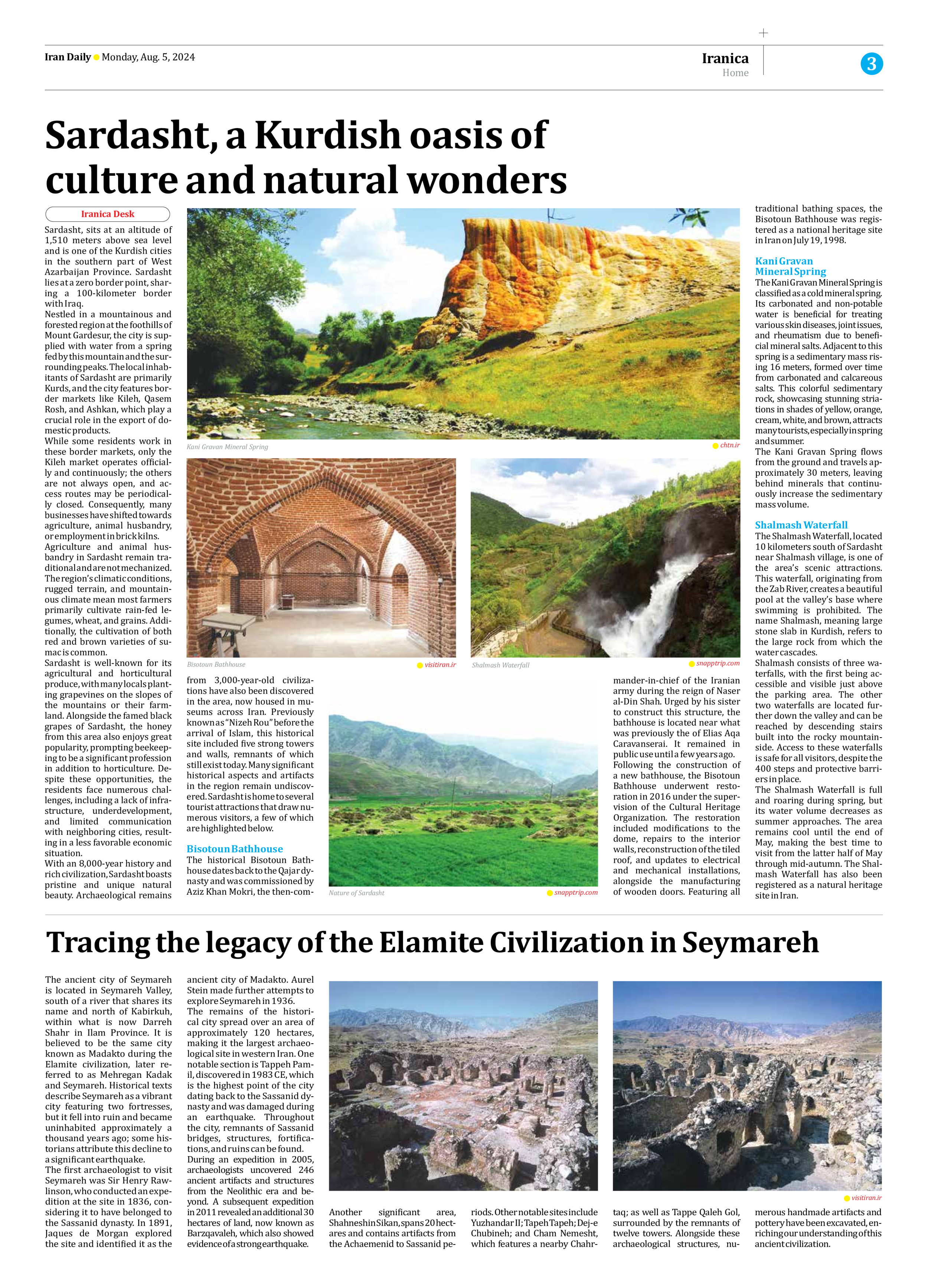
Sardasht, a Kurdish oasis of culture and natural wonders
Sardasht, sits at an altitude of 1,510 meters above sea level and is one of the Kurdish cities in the southern part of West Azarbaijan Province. Sardasht lies at a zero border point, sharing a 100-kilometer border with Iraq.
Nestled in a mountainous and forested region at the foothills of Mount Gardesur, the city is supplied with water from a spring fed by this mountain and the surrounding peaks. The local inhabitants of Sardasht are primarily Kurds, and the city features border markets like Kileh, Qasem Rosh, and Ashkan, which play a crucial role in the export of domestic products.
While some residents work in these border markets, only the Kileh market operates officially and continuously; the others are not always open, and access routes may be periodically closed. Consequently, many businesses have shifted towards agriculture, animal husbandry, or employment in brick kilns.
Agriculture and animal husbandry in Sardasht remain traditional and are not mechanized. The region’s climatic conditions, rugged terrain, and mountainous climate mean most farmers primarily cultivate rain-fed legumes, wheat, and grains. Additionally, the cultivation of both red and brown varieties of sumac is common.
Sardasht is well-known for its agricultural and horticultural produce, with many locals planting grapevines on the slopes of the mountains or their farmland. Alongside the famed black grapes of Sardasht, the honey from this area also enjoys great popularity, prompting beekeeping to be a significant profession in addition to horticulture. Despite these opportunities, the residents face numerous challenges, including a lack of infrastructure, underdevelopment, and limited communication with neighboring cities, resulting in a less favorable economic situation.
With an 8,000-year history and rich civilization, Sardasht boasts pristine and unique natural beauty. Archaeological remains from 3,000-year-old civilizations have also been discovered in the area, now housed in museums across Iran. Previously known as “Nizeh Rou” before the arrival of Islam, this historical site included five strong towers and walls, remnants of which still exist today. Many significant historical aspects and artifacts in the region remain undiscovered. Sardasht is home to several tourist attractions that draw numerous visitors, a few of which are highlighted below.
Bisotoun Bathhouse
The historical Bisotoun Bathhouse dates back to the Qajar dynasty and was commissioned by Aziz Khan Mokri, the then-commander-in-chief of the Iranian army during the reign of Naser al-Din Shah. Urged by his sister to construct this structure, the bathhouse is located near what was previously the of Elias Aqa Caravanserai. It remained in public use until a few years ago.
Following the construction of a new bathhouse, the Bisotoun Bathhouse underwent restoration in 2016 under the supervision of the Cultural Heritage Organization. The restoration included modifications to the dome, repairs to the interior walls, reconstruction of the tiled roof, and updates to electrical and mechanical installations, alongside the manufacturing of wooden doors. Featuring all traditional bathing spaces, the Bisotoun Bathhouse was registered as a national heritage site in Iran on July 19, 1998.
Kani Gravan
Mineral Spring
The Kani Gravan Mineral Spring is classified as a cold mineral spring. Its carbonated and non-potable water is beneficial for treating various skin diseases, joint issues, and rheumatism due to beneficial mineral salts. Adjacent to this spring is a sedimentary mass rising 16 meters, formed over time from carbonated and calcareous salts. This colorful sedimentary rock, showcasing stunning striations in shades of yellow, orange, cream, white, and brown, attracts many tourists, especially in spring and summer.
The Kani Gravan Spring flows from the ground and travels approximately 30 meters, leaving behind minerals that continuously increase the sedimentary mass volume.
Shalmash Waterfall
The Shalmash Waterfall, located 10 kilometers south of Sardasht near Shalmash village, is one of the area’s scenic attractions. This waterfall, originating from the Zab River, creates a beautiful pool at the valley’s base where swimming is prohibited. The name Shalmash, meaning large stone slab in Kurdish, refers to the large rock from which the water cascades.
Shalmash consists of three waterfalls, with the first being accessible and visible just above the parking area. The other two waterfalls are located further down the valley and can be reached by descending stairs built into the rocky mountainside. Access to these waterfalls is safe for all visitors, despite the 400 steps and protective barriers in place.
The Shalmash Waterfall is full and roaring during spring, but its water volume decreases as summer approaches. The area remains cool until the end of May, making the best time to visit from the latter half of May through mid-autumn. The Shalmash Waterfall has also been registered as a natural heritage site in Iran.







